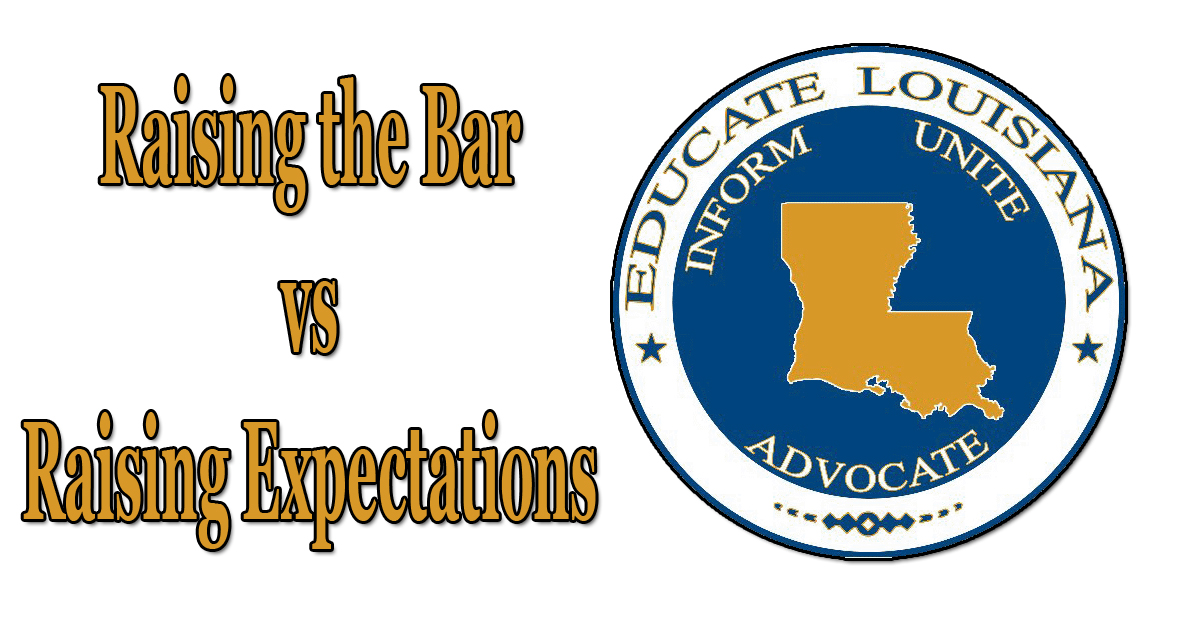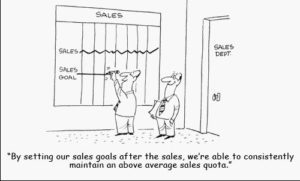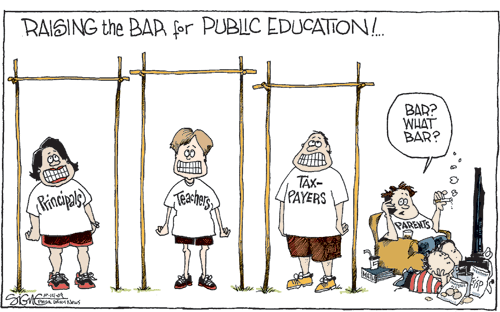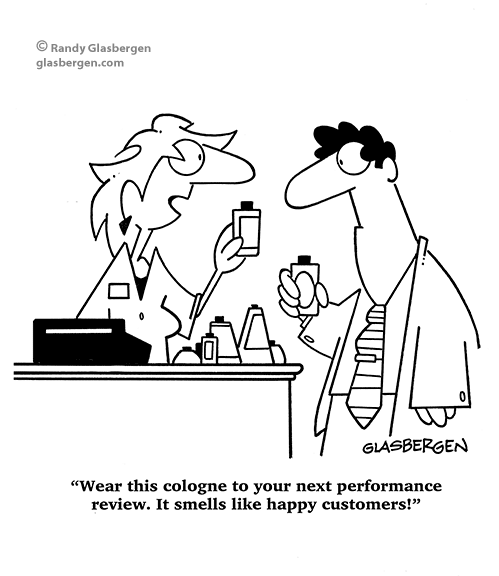
Although he probably thinks otherwise, I still hold a great deal of respect for a former administrator who once said, “If you want me to play the game, tell me the rules. And don’t change them in the middle of the game.” He was referring to school accountability and the importance of understanding how numbers affect your score. This is a concept that I wholeheartedly agree with; however, this is probably where our philosophies part ways. Some would do this faithfully and blindly with no regard for whether the measurement is fair or accurate. As a professional educator, and a father, I am obligated to oppose it when it isn’t.
 I’ve been teaching fifteen years. Before becoming a teacher, I spent fifteen years working loss prevention for a major retailer, and the parallels between accountability and sales goals are scary. My job was to analyze data and identify theft; primarily internal theft. I can tell you. When an employee’s job security and compensation depends on numbers, they will find creative ways to count. For example, I had a store manager once who consistently got recognition for store performance and got huge bonuses, as a result. It turns out that the manager understood the numbers so well that he figured out a way to move dollars from mark downs, which are a loss, to service agreements. In the retail business, service agreements are considered almost pure profit. He got caught. He lost his job. A concept similar to this in education accountability is the practice of shifting focus and resources away from the neediest students and concentrating it on the students who just need a nudge to reach the mark. This helps raise the school score, but does nothing for the neediest students.
I’ve been teaching fifteen years. Before becoming a teacher, I spent fifteen years working loss prevention for a major retailer, and the parallels between accountability and sales goals are scary. My job was to analyze data and identify theft; primarily internal theft. I can tell you. When an employee’s job security and compensation depends on numbers, they will find creative ways to count. For example, I had a store manager once who consistently got recognition for store performance and got huge bonuses, as a result. It turns out that the manager understood the numbers so well that he figured out a way to move dollars from mark downs, which are a loss, to service agreements. In the retail business, service agreements are considered almost pure profit. He got caught. He lost his job. A concept similar to this in education accountability is the practice of shifting focus and resources away from the neediest students and concentrating it on the students who just need a nudge to reach the mark. This helps raise the school score, but does nothing for the neediest students.
Because so much of what is happening in education is based on the “business model,” I want to draw some additional comparisons related to performance, achievement and accountability. There is a distinct difference between raising expectations and raising the bar. It is important to understand the difference and which one is incorrectly being used as the leading indicator of success in our schools.
 In general, “the bar” is the level of performance, or achievement, that is required to attain “mastery” and/or “success.” The bar should be set at a level that is attainable by your top performers and some of your best middle performers. If half or more of your testers are able to attain mastery, then it is necessary to increase the required level of performance. This is called “raising the bar.” Statistical analysis tells us that there will always be top performers who can reach the bar, but raising the bar above the reach of those performers does nothing but alienate the ones who couldn’t reach it, before.
In general, “the bar” is the level of performance, or achievement, that is required to attain “mastery” and/or “success.” The bar should be set at a level that is attainable by your top performers and some of your best middle performers. If half or more of your testers are able to attain mastery, then it is necessary to increase the required level of performance. This is called “raising the bar.” Statistical analysis tells us that there will always be top performers who can reach the bar, but raising the bar above the reach of those performers does nothing but alienate the ones who couldn’t reach it, before.
Raising expectations is communicating to those who have not reached the bar that there is an expectation of success via increased effort, and that the assumption that a student has peaked is unacceptable. In Louisiana, we have not raised expectations. We have raised the bar before there was substantial achievement at the previous level. We did that by implementing academic standards that demand that a student perform two and even three grade levels above their cognitive development, and we assess them and label them based on their inability to attain the goal. The results are then used to evaluate teachers and rate schools. With the newly implement accountability plan under ESSA, we have now set the bar at a level in which the top performers will be labeled inadequate.
This concept can be easily illustrated in retail so that most people can relate. Two store managers run retail outlets 50 miles apart in similar markets. The company’s standard goal for annual sales is a 5% increase over the previous year’s sales with a minimum of 15% of the sales being service agreements. In the last three years, neither of the stores met their sales goal, nor did they meet their service agreement goal. They were both told by the district manager that if they didn’t meet their goals in the fourth year, they would be fired.
 Manager One returned to his store and held a store meeting. He angrily told his staff that their schedules would change from 5 eight hour days to 6 ten hour days. The logic being that he needed as many sales people on the floor as possible, at all times. In addition, the expected service agreement goal would be raised from the the normal 15% to 20%.
Manager One returned to his store and held a store meeting. He angrily told his staff that their schedules would change from 5 eight hour days to 6 ten hour days. The logic being that he needed as many sales people on the floor as possible, at all times. In addition, the expected service agreement goal would be raised from the the normal 15% to 20%.
Manager Two returned to his store and held a store meeting. He asked his staff what they thought were the reasons they weren’t meeting goals. He learned that more often than not, advertised items were not in stock. The quality of some merchandise was inferior and often resulted in item returns. In addition, the general public doesn’t like to be upsold , and a large number of staff felt that they weren’t knowledgeable enough to convert customers who were resistant to being upsold. He committed to his staff to fix all of these concerns, and in return, expected them to meet their goals.
At the end of the 4th year, the two managers returned to the district office. Manager One had still not met the sales goal, or the service agreement goal. Manager Two had met both. Manager One had given the illusion of raising expectations by raising the bar when the majority of the staff had not met the current bar. Manager Two determined the barriers to meeting the bar and worked to remove them with the expectation that the staff would increase their effort to meet the bar.
These are two very different approaches with very different outcomes. You can generalize this to evaluating teachers, as well. Manager One identified the sole source of his failure as the inability of the staff to meet expectations. Manager Two acknowledged that achieving desired outcomes depends on more than just the salesperson’s ability to sale. You can make the following comparisons in education.
- Salesperson–Teacher
- Quality of merchandise–Standards and Curriculum
- Available Inventory–Adequate resources
- Customer Ability to Buy–Social barriers to student success
- Customer willingness to Buy–Student motivation
The changes made in Louisiana are clearly the approach taken by Manager One. His goals were sales centered. We need to be taking Manager Two’s approach with the goal of serving the customer. The sales will follow.


Awesome!!!!!!!